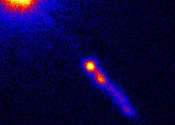Volcano-like rupture could have caused magnetar slowdown
On Oct. 5, 2020, the rapidly rotating corpse of a long-dead star about 30,000 light years from Earth changed speeds. In a cosmic instant, its spinning slowed. And a few days later, it abruptly started emitting radio waves.









